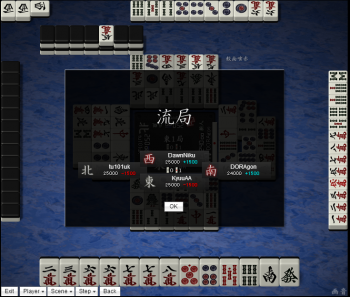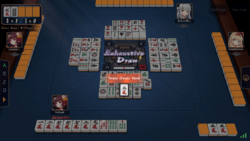Ryuukyoku: Difference between revisions
m (→Seat rotation) |
(use bullets in the intro) |
||
| Line 1: | Line 1: | ||
[[Image:Ryuukyoku.png|thumb|right|350px|[http://tenhou.net/0/?log=2014020716gm-0009-7447-c1bce130&tw=0 Point exchange at ryuukyoku].]] | [[Image:Ryuukyoku.png|thumb|right|350px|[http://tenhou.net/0/?log=2014020716gm-0009-7447-c1bce130&tw=0 Point exchange at ryuukyoku].]] | ||
'''Ryuukyoku''' {{kana|流局}}, or '''exhaustive draw''', is a way of ending a hand. It occurs when [[haiyama|all the tiles]] (excluding those in the [[dead wall]]) have been drawn, and no player manages to produce a winning hand. After the player with the [[haitei|last tile]] draw makes a discard, if no one claims a win, then the hand simply ends in "exhaustive draw". | '''Ryuukyoku''' {{kana|流局}}, or '''exhaustive draw''', is a way of ending a [[kyoku|hand]]. It occurs when [[haiyama|all the tiles]] (excluding those in the [[dead wall]]) have been drawn, and no player manages to produce a winning hand. After the player with the [[haitei|last tile]] draw makes a discard, if no one claims a win, then the hand simply ends in "exhaustive draw". During an exhaustive draw: | ||
* Players in [[tenpai]] reveal their hands, then receive points from players who are in noten (not tenpai). | |||
* [[Jikaze|Wind seating]] may rotate, depending on the [[dealer]]'s hand and [[Rule variations#Agariyame|the ruleset]]. | |||
** Under many rulesets: if the [[dealer]] is in tenpai, the seats do not rotate; otherwise, the seats rotate. | |||
** In some rulesets, the winds rotate regardless of the dealer's tenpai status. | |||
* The [[honba]] count increases by 1. | |||
Afterwards, a new hand starts. While the term "ryuukyoku" is usually used to refer to an exhaustive draw in Japanese, on occasion this may be ambiguous, as the term technically refers to any draw (cf. [[tochuu ryuukoku]], {{kana|途中流局}}). When ambiguity occurs, it may be referred to as '''tsuujou no ryuukyoku''' {{kana|通常の流局}}, which translates roughly as "usual kind of draw". | |||
While the term "ryuukyoku" is usually used to refer to an exhaustive draw in Japanese, on occasion this may be ambiguous, as the term technically refers to any draw (cf. [[tochuu ryuukoku]], {{kana|途中流局}}). When ambiguity occurs, it may be referred to as '''tsuujou no ryuukyoku''' {{kana|通常の流局}}, which translates roughly as "usual kind of draw". | |||
Nearly 40% of professional games go to an exhaustive draw due to players immediately [[betaori|abandoning the hand]] when a player declares [[riichi]]. | Nearly 40% of professional games go to an exhaustive draw due to players immediately [[betaori|abandoning the hand]] when a player declares [[riichi]]. | ||
| Line 24: | Line 26: | ||
Any [[riichi]] bets left on the table are saved for later rounds. The next player that wins claims all leftover riichi bets. | Any [[riichi]] bets left on the table are saved for later rounds. The next player that wins claims all leftover riichi bets. | ||
Players in noten are not required to reveal their hands. When playing with physical tiles, players in tenpai may (intentionally or not) declare noten, losing out on the tenpai points. | |||
See the [[#Tenpai|Tenpai]] section below for the general definition of "tenpai" used by ryuukyoku. | See the [[#Tenpai|Tenpai]] section below for the general definition of "tenpai" used by ryuukyoku. | ||
Revision as of 17:40, 29 August 2024

Ryuukyoku 「流局」, or exhaustive draw, is a way of ending a hand. It occurs when all the tiles (excluding those in the dead wall) have been drawn, and no player manages to produce a winning hand. After the player with the last tile draw makes a discard, if no one claims a win, then the hand simply ends in "exhaustive draw". During an exhaustive draw:
- Players in tenpai reveal their hands, then receive points from players who are in noten (not tenpai).
- Wind seating may rotate, depending on the dealer's hand and the ruleset.
- Under many rulesets: if the dealer is in tenpai, the seats do not rotate; otherwise, the seats rotate.
- In some rulesets, the winds rotate regardless of the dealer's tenpai status.
- The honba count increases by 1.
Afterwards, a new hand starts. While the term "ryuukyoku" is usually used to refer to an exhaustive draw in Japanese, on occasion this may be ambiguous, as the term technically refers to any draw (cf. tochuu ryuukoku, 「途中流局」). When ambiguity occurs, it may be referred to as tsuujou no ryuukyoku 「通常の流局」, which translates roughly as "usual kind of draw".
Nearly 40% of professional games go to an exhaustive draw due to players immediately abandoning the hand when a player declares riichi.
Summary
Unless a chombo occurs, the following happens during an exhaustive draw:
Point Exchanges
If some players are tenpai and others are not, points are exchanged. The players in noten pay a combined sum of 3000 points, split between players in tenpai. This results in the following score table:
- 0 players in tenpai: No points exchanged.
- 1 player in tenpai: All players in noten pays 1,000 points to the tenpai player.
- 2 players in tenpai: Each player in noten pays 1,500 points, each player in tenpai receives 1,500 points.
- 3 players in tenpai: The single player in noten pays 1,000 points to each player in tenpai.
- 4 players in tenpai: No points exchanged.
If a player qualifies for nagashi mangan, all point exchanges from tenpai are skipped. Instead, players pay a "reverse mangan tsumo" to the players with nagashi mangan. For each player with naganshi mangan, the dealer pays 4000 points and non-dealers pay 2000 points.
Any riichi bets left on the table are saved for later rounds. The next player that wins claims all leftover riichi bets.
Players in noten are not required to reveal their hands. When playing with physical tiles, players in tenpai may (intentionally or not) declare noten, losing out on the tenpai points.
See the Tenpai section below for the general definition of "tenpai" used by ryuukyoku.
Seat rotation
Wind seat rotation is dependent on the dealer's hand state. If the dealer's hand is tenpai, then renchan is applied and wind seating does not rotate. If the dealer's hand is noten, then the wind seating rotates. (However, in some rule variations, the winds rotate even if the dealer is in tenpai.)
Regardless of wind rotation, after an exhaustive draw, the honba count increases by 1
Tenpai
Tenpai is the state of the hand waiting on just one tile to claim for a win, either by draw or discard. When an exhaustive draw happens, a win is no longer possible, but a small point bonus is given.
Karaten

A hand may be in tenpai but be unable to win in the actual game. For example, all the winning tiles could've been discarded before reaching tenpai. This is known as karaten.
Whether such hands count as tenpai depends on rule variation. Under many rulesets:
- A hand with no yaku counts as tenpai for ryuukyoku.
- A hand in furiten counts as tenpai.
- A hand with all possible winning tiles discarded (or otherwise unavailable) counts as tenpai.
- A hand with all possible winning tiles in the player's own hand (see below) does not count as tenpai.
For an example of the last case:
Despite the hand being one tile away from completion, all of the possible winning tiles are in the player's own closed kan. So, instead of gaining points, the player is considered noten. (However, this, like the other points, is subject to rule variation.)
Chombo
A player is not allowed to call a riichi without tenpai. If a player declares noten riichi, and the hand ends in ryuukyoku, the player is penalized for chombo.
No wind rotation is applied, and no point exchanges are applied. The honba count is not increased. The next hand continues as if the chombo hand did not even occur. Of course, the appropriate penalty for chombo is applied and the game continues.
Strategy
Sometimes, the ryuukyoku point exchanges is enough to determine the final position in games, especially in oorasu (the last hand). Dealers in tight point races need to take particular note about the need to attain tenpai or allow the game to end. It may be desirable to pass on a small winning hand in order to collect the payment from noten players instead.
External links
- Ryuukyoku in Japanese Wikipedia